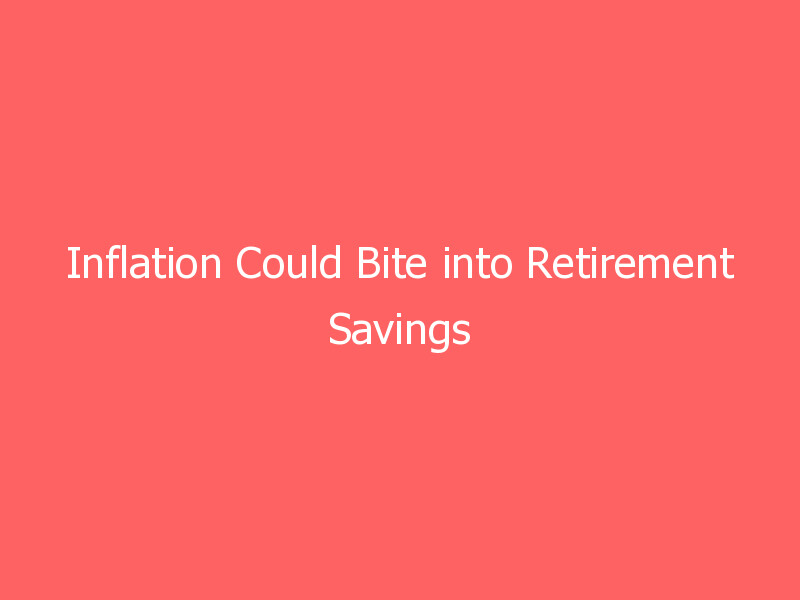Inflation Could Bite into Retirement Savings
[This article is the third in a three-part series. Part one focused on inflation and compensation. Part two focused on inflation and health care costs.]
If inflation rates trend higher over the coming years, as is expected, retirement plan sponsors may need to adjust their plans’ investment options. Likewise, plan participants should consider increasing their savings deferral rates, if possible.
As noted in part one of this series, the consumer price index (CPI) in May rose 5 percent from 12 months earlier, which is the largest yearly gain since August 2008,
the Labor Department reported on June 10. In comparison, the CPI
rose 1.6 percent year over year for 2020.
Some economists expect the recent surge in prices to moderate but warn that inflation may still be significantly higher over the coming years.
While the Social Security cost-of-living increase for retirees was 1.3 percent for 2021,
Kiplinger reports it’s
likely to tick up to 4.5 percent next year, the biggest jump since 2008. That’s an indication of the challenge facing 401(k) accounts, which, unlike Social Security, don’t adjust automatically to keep pace with inflation.
“Even a 3 percent inflation rate can mean the cost of living can double within 24 years,” Kelly LaVigne, vice president of advanced markets for Allianz Life Insurance Co., wrote on the
Kiplinger website. “It’s no wonder then that over half (57 percent) of Americans are worried inflation will make basic retirement expenses unaffordable,” he added, citing Allianz Life’s 2020
Retirement Risk Readiness Study, with responses from 1,000 U.S. adults.
401(k) Plan Considerations
For employees who are saving through 401(k) or similar defined contribution plans, “the impact of higher inflation is currently being felt by participants in the short run, as inflation has caused interest rates to rise and the value of bond funds to fall,” said Robert Janson, senior vice president for wealth management and senior portfolio manager at benefits broker GCG Financial, an Alera Company.
“In the long run, if inflation persists, participants will have to save more to overcome higher prices for goods and services in the future,” he noted.
According to investment firm TIAA, plan sponsors should “make sure your investment lineup is structured appropriately for changing market environments, such as rising interest rates.” As plan sponsors review their plan’s investment menu, they “may want to … consider the implications of rising rates and whether your investment options address this market environment.”
‘Consider the implications of rising rates and whether your investment options address this market environment.’
Plans may consider adding inflation hedges, such as Treasury Inflation-Protected Securities (TIPs) bond funds, for example.
When evaluating how target-date funds may perform in a rising-rate environment, TIAA advised plan sponsors to “consider the fund’s glidepath,” or the way the mix of stocks and bonds changes as the target retirement date nears. For instance, “a higher glidepath allocation to equities may offer stronger performance when rates rise, in addition to helping address longevity risk,” which is the danger of outliving retirement savings.
“It’s been such a long time since we’ve had to worry about inflation that
people may have forgotten how to deal with it in terms of their retirement investments,” wrote Chris Carosa, chief contributing editor at FiduciaryNews.com. To help plan participants incorporate inflation into their retirement planning, “plan sponsors ought to stick to the simple and let the service providers determine whether it makes sense” to adjust their 401(k) investment menus and, if so, what changes might be prudent, he advised.
[Want to learn more about retirement benefits? Join us at the SHRM Annual Conference & Expo 2021, taking place Sept. 9-12 in Las Vegas and virtually.]
Pension Plan Issues
For defined benefit pension plans, the situation is different.
“Higher inflation, if it persists, will produce higher interest rates, which would in turn reduce pension liabilities [future payouts that a pension is obligated to make], which is good news for pension sponsors,” said Brian Donohue, a partner at retirement plan advisory firm October Three.
Interest rates also have an inverse relationship with lump-sum pension payouts—when interest rates rise, the amount of lump-sum payouts falls.
“CPI inflation over the past year has been 5 percent, and interest rates have moved up as a result,” he noted, adding that a typical pension plan has seen its liabilities decrease about 5 percent since the beginning of 2021.
“To the extent that plan liabilities are unfunded, a decrease in liabilities directly improves the company’s net worth,” Donohue said.
Higher inflation and interest rates may reduce a plan’s investment returns, he noted, “but probably not by as much as they reduce liabilities.”
Retirees and Interest Rates
The Federal Reserve ties interest rates to inflation. Over the past several years, low interest rates on savings accounts, money market funds and short-term bonds have made it difficult for retirees to earn enough interest to supplement Social Security, according to MarketWatch columnist Paul Randus.
Lower returns from money market funds and certificates of deposits have been “tough news for anyone hoping to squeeze more out of their savings,” he wrote recently.
As interest rates rise along with inflation, retirees would earn more from these investments—but higher prices also could wipe out those gains in short order.
[The other parts of this series are
Inflation’s Return Will Affect Compensation and
Inflation, Other Factors, Drive Up Health Care Costs.]
Originally found on SHRM Read More








